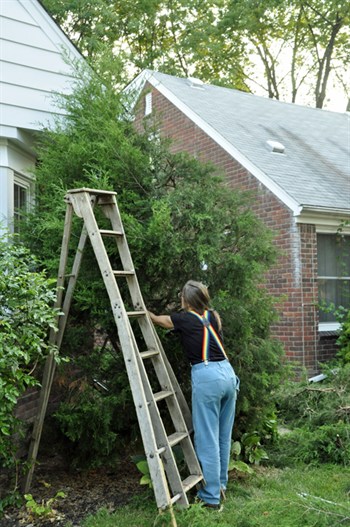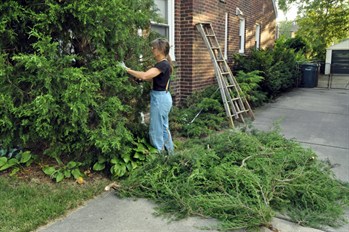No perfect subject in the real world
This little tree could serve in another of our pruning stories,
Cut n
expectations, as an example of what's reasonable to expect
of a juniper cut back after having been allowed to become too
large.
Because it was 'way too big -- larger than what you see below in
this year's "before" image, yet still only about half its 40-foot
potential -- and since juniper does not develop new leaf from bare
wood, it's been a slow process developing some foliage in what was
an almost-totally woody center when we first started working on
this 5 years ago.
Right, and below,
right. The first cut was very hard and left the tree quite
thin.
Some of the cuts we made left a big limb an inch in diameter
with only a wisp of foliage at its tip. That's a lot of wood to ask
a tiny bit of greenery to support! Some of those branches made it,
but some eventually died back and had to be taken out entirely.

Yet we see the interior is gradually getting leafier. (Take a look to compare this initial "after"
to how it looks two cuts and 5 years later, and judge for
yourself.)
So, now we've cut the tree three times -- every two years. We
pick up the story here at that third cut.
Below: As we did for the blue spruce we showed you in
Reduce a
spruce, we start by taking the top down, and then come down
each face of the tree, reducing the length of the side branches as
we descend.



Right: We take out quite a bit of green. We could take less,
and cut more frequently. However, we put this tree on a two-year
pruning cycle -- we cut back far enough each time to allow it to
grow for two years. (Why? Because why do the work more often than
necessary? And who wants to deal with a picky juniper more often
than that?
Below: The before
and after from cut #3. Still a bit dumpy in form but fuller after
this cut than that first time (take a look
again). Perhaps two years from now when we cut it again,
we can improve the shape from chubby spindle to more svelte column.
Stick with us and you'll see!

